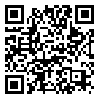Volume 7, Issue 2 (Summer 2024)
Iran J Health Insur 2024, 7(2): 102-113 |
Back to browse issues page
Research code: 2858252
Download citation:
BibTeX | RIS | EndNote | Medlars | ProCite | Reference Manager | RefWorks
Send citation to:



BibTeX | RIS | EndNote | Medlars | ProCite | Reference Manager | RefWorks
Send citation to:
Izadi L, Elahi S, Hassanzadeh A, Shafiee S. Towards Intelligent Supervision in Health Insurance: Steps to Achieving Monitoring and Evaluation Framework. Iran J Health Insur 2024; 7 (2) :102-113
URL: http://journal.ihio.gov.ir/article-1-312-en.html
URL: http://journal.ihio.gov.ir/article-1-312-en.html
1- Department of Information Technology Management, Tarbiat Modares University, Tehran, Iran
2- Department of Information Technology Management, Vali Asr University, Rafsanjan, Iran
3- Department of Information Technology Management, Payam Noor University, Tehran, Iran ,s.shafiei@pnu.ac.ir
2- Department of Information Technology Management, Vali Asr University, Rafsanjan, Iran
3- Department of Information Technology Management, Payam Noor University, Tehran, Iran ,
Abstract: (440 Views)
Introduction: Health insurance, as one of the pillars of the health system and responsible for financially protecting individuals in society against the risk of diseases, also requires an effective monitoring system. This research aims to examine the issues of supervision in health insurance and provide steps to achieve a monitoring and evaluation framework towards Intelligence supervision.
Methods: In this study, data were collected from qualitative interviews with health insurance experts and the analysis of secondary data. The proposed PAVA model in health insurance was designed and evaluated based on key indicators extracted from previous studies. Experts were selected using the snowball method until data saturation was reached, resulting in a total of 24 interviews. During the interviews, notes were taken, and the interviews were recorded and analyzed using Atlas.ti8 software. Based on the steps of PAVA and business intelligence, the steps to create the PAVA framework in health insurance were presented.
Results: The health insurance organization has various systems such as medical records, the Omid system, Didban system, eligibility assessment, business partner systems, and electronic prescription. Monitoring is conducted both in-person and remotely. Data analysis from the interviews revealed that monitoring in health insurance faces several challenges. These challenges include the need for data collection, aggregation, and cleansing, the need for data analysis, and the need for an integrated and interactive monitoring system. Specifically, issues such as the lack of comprehensive electronic data, the need for better access to data, and the need for more precise data analysis to identify fraud and misuse were identified.
Conclusion: The results of this study can be used by senior managers of health insurance organizations, managers and experts in the supervision departments, IT managers and experts, organizational knowledge managers, and knowledge workers of the organization, as well as the National Health Insurance Research Center. These findings help improve the efficiency and effectiveness of the supervision system, thereby enhancing the overall performance of the health insurance organization
Methods: In this study, data were collected from qualitative interviews with health insurance experts and the analysis of secondary data. The proposed PAVA model in health insurance was designed and evaluated based on key indicators extracted from previous studies. Experts were selected using the snowball method until data saturation was reached, resulting in a total of 24 interviews. During the interviews, notes were taken, and the interviews were recorded and analyzed using Atlas.ti8 software. Based on the steps of PAVA and business intelligence, the steps to create the PAVA framework in health insurance were presented.
Results: The health insurance organization has various systems such as medical records, the Omid system, Didban system, eligibility assessment, business partner systems, and electronic prescription. Monitoring is conducted both in-person and remotely. Data analysis from the interviews revealed that monitoring in health insurance faces several challenges. These challenges include the need for data collection, aggregation, and cleansing, the need for data analysis, and the need for an integrated and interactive monitoring system. Specifically, issues such as the lack of comprehensive electronic data, the need for better access to data, and the need for more precise data analysis to identify fraud and misuse were identified.
Conclusion: The results of this study can be used by senior managers of health insurance organizations, managers and experts in the supervision departments, IT managers and experts, organizational knowledge managers, and knowledge workers of the organization, as well as the National Health Insurance Research Center. These findings help improve the efficiency and effectiveness of the supervision system, thereby enhancing the overall performance of the health insurance organization
Type of Study: Research |
Subject:
Special
Received: 2024/02/11 | Revised: 2024/10/12 | Accepted: 2024/08/18 | ePublished: 2024/10/12
Received: 2024/02/11 | Revised: 2024/10/12 | Accepted: 2024/08/18 | ePublished: 2024/10/12
Send email to the article author
| Rights and permissions | |
 |
This work is licensed under a Creative Commons Attribution-NonCommercial 4.0 International License. |






